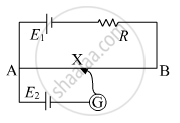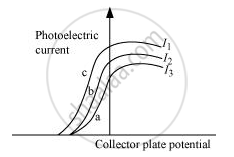Advertisements
Advertisements
Question
Can there be a potential difference between two adjacent conductors carrying the same charge?
Solution
Yes, if the sizes are different.
Explanation: We define capacitance of a conductor C = Q/V is the charge of conductor and V is the potential of the conductor. For given charge potential V `oo` 1/C. The capacity of conductor depends on its geometry, so two adjacent conductors carrying the same charge of different dimensions may have different potentials.
APPEARS IN
RELATED QUESTIONS
Draw a labelled diagram of Van de Graaff generator. State its working principle to show how by introducing a small charged sphere into a larger sphere, a large amount of charge can be transferred to the outer sphere. State the use of this machine and also point out its limitations.
In the circuit diagram given below, AB is a uniform wire of resistance 15 Ω and length 1 m. It is connected to a cell E1 of emf 2V and negligible internal resistance and a resistance R. The balance point with another cell E2 of emf 75 mV is found at 30 cm from end A. Calculate the value of R.

Draw a schematic diagram and explain the working of Van de Graff generator device.
Is there any restriction on the upper limit of the high voltage set up in Van de Graff generator machine? Explain.
The figure shows a plot of three curves a, b, c, showing the variation of photocurrent vs collector plate potential for three different intensities I1, I2and I3 having frequencies v1, v2 and v3 respectively incident of a photosensitive surface.
Point out the two curves for which the incident radiations have same frequency but different intensities.

Find the potential difference between the points A and B and between the points B and C of the figure in steady state.

A charge of `+2.0 xx 10^-8 C` is placed on the positive plate and a charge of `-1.0 xx 10^-8 C` on the negative plate of a parallel-plate capacitor of capacitance `1.2 xx 10^-3 "uF"` . Calculate the potential difference developed between the plates.
In circuits, a difference in potential from one point to another is often called ______.
On moving a charge of Q coulomb by X cm, W J of work is done, then the potential difference between the points is ______.
If potential difference between the two ends of a metallic wire is doubled, drift speed of free electrons in the wire ______.
